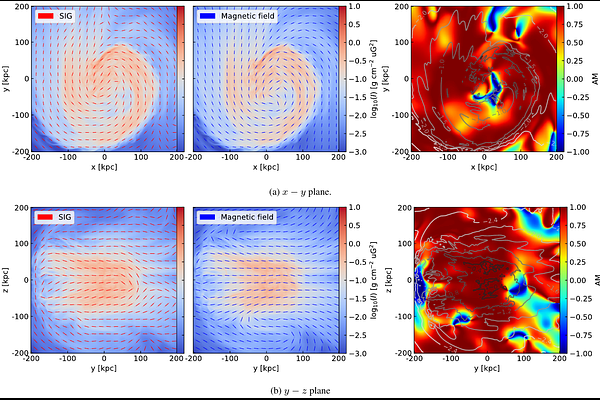The Statistics of Gas Density, Velocity, and Magnetic Fields in Cool-Core Galaxy Clusters

The Statistics of Gas Density, Velocity, and Magnetic Fields in Cool-Core Galaxy Clusters
Yue Hu, Alex Lazarian, G. Brunetti, John A. ZuHone
AbstractUnderstanding turbulence within the Intracluster Medium (ICM) of galaxy clusters is pivotal for comprehending their evolution and dynamics. Employing 3D magnetohydrodynamic (MHD) simulations of galaxy cluster mergers, we examine the statistical properties of gas density, magnetic fields, and velocity, particularly emphasizing the central regions spanning 400 kpc. The simulations feature varied initial plasma $\beta$ values (100, 200, and 500), mirroring conditions in massive cool-core clusters such as Perseus. Our findings indicate that while the statistical histogram distributions of gas density and velocity appear similar across different $\beta$ scenarios, their spatial distributions and morphological patterns exhibit noticeable differences. Through the application of the second-order structure function, we identified a scaling relation in velocity fluctuations, characterized by a slope of 1/2 and predominantly dominated by solenoidal components. Furthermore, our analysis reveals a pronounced anisotropy in both velocity and magnetic field fluctuations, with more significant fluctuations along the direction perpendicular to the magnetic fields. This anisotropy is scale-dependent, becoming more pronounced at smaller scales, and exhibits a decreasing trend in scenarios where the magnetic field is relatively weak, particularly at $\beta=500$. This suggests that the anisotropic nature of these fluctuations is predominantly regulated by the magnetic fields. Additionally, we test the efficacy of the Synchrotron Intensity Gradient (SIG) method for tracing magnetic fields in these environments. The SIG shows a global agreement with the magnetic field across all three $\beta$ scenarios, confirming the SIG's insensitivity to the medium's magnetization level.